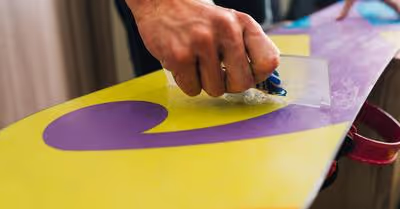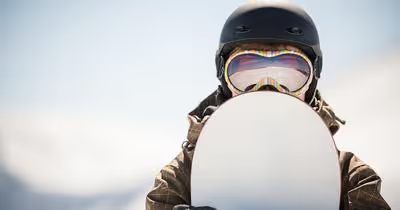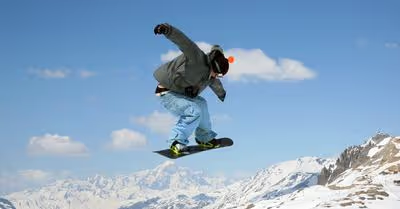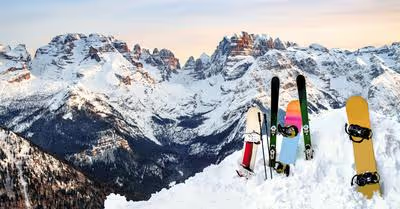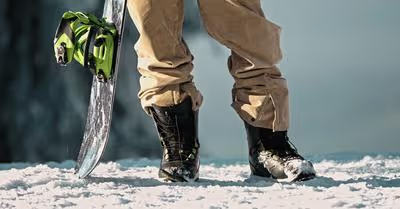Table of Contents
Beginner Vs Advanced Snowboards
The board is the most important piece of equipment in snowboarding. It is what you use to ride down the slopes and get that speed. If you are a beginner, you may not know much about snowboards, but your board type is critical to your success.
Beginner boards have a rounded shape with a softer flex pattern that makes it easier for beginners to learn how to snowboard. Advanced boards are usually stiffer and have sharper edges that make them more responsive for advanced riders.
The differences between beginner & advanced snowboards are not only in their design but also in their performance. Beginners will find that they can go faster on beginner boards while more experienced riders will find that they can perform better tricks with an advanced board.
You should consider your skill level and riding experience when deciding on a snowboard. The manufacturer also uses labels to indicate who should use a specific board, making it helpful for buyers to find the perfect match.
Beginner Snowboard
Beginner snowboards are designed for people who are new to the sport and don't know how to snowboard. They have a wide base, a short nose, and a wide tail. This allows beginners to easily balance on the board and steer it.
A beginner snowboard has a simple design with a forgiving board shape to provide excellent balance. They are usually smaller than other boards and are easier to carry because they are not as heavy as more advanced designs.
Beginners typically start with these types of boards because they are cheaper and easier to learn on. It is usually smaller and lighter than a regular board, and it does not have many features.
A beginner snowboard can be used to learn the basics of how to ride on a snowboard. It is also good for younger riders who are just learning how to ride on a snowboard. They are cheaper and easier to use than an advanced snowboard too.
The best beginner board will have a centered stance, symmetrical nose and tail, forgiving edges, and a softer flex pattern. They are also designed to be easy to turn on the board while riding.
A beginner snowboard can be used by anyone who has never ridden before. They are easy to learn and often have a simple shape that makes them easier for beginners to handle.
Beginners need to start with an inexpensive board so they don't get discouraged from riding as they progress in their skillset.
Advanced Snowboard
Advanced snowboards have a narrower base, shorter noses, and narrower tails. This gives advanced riders more control over their boards as they can ride faster with less effort.
An advanced snowboard is a snowboard that has been designed with a specific focus on the rider’s ability. The build of a rider and the style of terrain you intend to use it on are also key factors.
These boards are usually built with a more progressive shape and construction materials, which makes them lighter and easier to turn. They also tend to have a longer length, which helps the rider maintain balance while they are in the air.
An advanced snowboard is typically made of high-end materials such as carbon fiber and titanium. This allows for greater responsiveness and strength during turns. They also have a better grip, better performance, and more features.
The advanced snowboard is an all-terrain board that can ride on different types of terrain. It is also customizable for different riding styles. The board can be used for freestyle and downhill riding.
This type of snowboard is designed to be more maneuverable and responsive. It also features a wider stance which makes it easier to ride in the park and on groomers.
The advanced snowboard can be used by expert riders who are looking for a board that will allow them to progress their skills. Once you have mastered the different flex ratings, terrain types, and snowboard profiles you can control an advanced snowboard on the slopes with ease.
Differences Between Beginner & Advanced Snowboards
The differences between beginner and advanced snowboards are in the base materials, shape, size, and design. The board type you use should be tailored towards your skill level to allow for the best board control too.
There are a few differences between beginner and advanced snowboards that you should be aware of before you invest in your next snowboard. Below you will learn more about these board features and how they differ between the two snowboard types.
Flex Rating
The flex rating on snowboards is extremely important and changes significantly between beginner and advanced snowboards too. The flex rating provides a better understanding of the board's performance characteristics.
It is an indicator of the board's stiffness concerning its length. From a beginner to an advanced board, the flex rating will change by a significant amount. It also gives information about how responsive the board is and how well it performs in different areas of snowboarding.
The flex rating can help you choose a snowboard that matches your skill level and will also help you improve your skills as you progress with your riding. The board type you use will have a flex rating that determines the type of forgiveness you have.
Beginner snowboards will have a softer flex because the lower a flex rating is, the more forgiving the board. This means that an advanced snowboard would be much stiffer with less flex.
It is critical to start with a soft flex and learn how to ride it. This will then allow you to gradually decrease the flex to best learn how to handle a stiffer snowboard.
Forgiveness
Many factors impact forgiveness on a snowboard, but beginner boards provide much more of it than advanced ones. Beginner boards have a wider and flatter base which makes it easier to turn, while advanced boards have smaller bases which makes turning harder.
The forgiveness on a snowboard is the amount of contact the board has with the ground. Beginner snowboards have a lot of forgiveness because they are designed to be used in a wide range of conditions.
Beginner snowboards provide much more of it than advanced ones. The design and material may also impact how forgiving it is, but most importantly, your weight will influence how forgiving it is.
The amount of contact the board has with the ground impacts how easy or difficult it will be to turn, ride up hills, or slide down hills. The more forgiving a board is, the easier it will be to ride in different environments and conditions such as powdery snow or ice.
Base Material
The base material is another important factor in choosing your first snowboard. Beginner snowboards use extruded bases because of the ease of maintenance and installation to keep your board in excellent shape.
The extruded bases have a slight performance advantage but it is not significant enough for people to switch from the standard type of base. It is ideal for beginners because it holds up and is highly versatile.
A sintered snowboard base is a type of snowboard base that is made from a mix of aluminum, fiberglass, and resin. This base type is less commonly used in the industry because it increases performance and durability but at a higher cost.
Sintered boards are also harder to maintain which is why many of the advanced and expensive boards use them. They offer a smoother ride overall due to their reduced friction with the snow, which means you'll be able to go faster without having to worry about slowing down.
Once you upgrade to an advanced board, you will realize the difference between an extruded and a sintered snowboard base. The same goes for the core used on the board as well.
Profile
The camber profile of a snowboard is the curvature of its side edges. The camber profile is important to the snowboarder because it affects how much edge contact the board has with the snow.
An advanced board has a more aggressive camber profile, which makes it easier to turn when riding. It has a very flat base and a sharp tip, which is designed for speed. However, the profile is highly customizable too.
A beginner board is more stable and easier to ride than an advanced board. Beginner boards are designed with a flatter base and sharper tip that is meant for stability.
Camber profiles are classified as either advanced or beginner depending on their shape. An advanced camber profile has a rounded top and bottom and a more pronounced sidecut, while a beginner camber profile has more of an angular shape with less of a side cut.
Shape
Snowboard shapes are designed to suit a variety of different skill levels and types of terrain. Beginner snowboards will be much shorter and narrower than advanced ones.
They will also have a softer flex pattern and less camber for beginners. These boards will be more forgiving in terms of riding ability, but may not perform as well as an advanced board on harder terrain like rails or jumps.
The beginner boards offer great versatility for those who want to learn how to snowboard without worrying about the performance aspect. For those who are just starting out, these boards can help them become comfortable with their skill set before moving on to more advanced designs.
For example, nearly all of the true beginner boards will use a true twin shape because it is ideal for beginners. The nose and tail are the same lengths so it creates the best balance to allow a center stance for board control.
Advanced snowboards will use directional shapes because they work best when moving in one direction. This means the nose is longer with a more directional profile too. It creates better contact points with the snow for improved performance.
Size
In snowboarding, the size of a board is not the only thing that matters. It also depends on your skill level and what you need to do with it.
The size of a snowboard is often an important factor for beginners who are looking for something that can help them learn how to snowboard. However, advanced riders will want something bigger and more stable as they progress in their skills.
The width of the board is also a factor as it affects how big or small the board will be. For beginners, it is recommended to get a smaller board because it will help them learn and progress more quickly.
Sidecut
The sidecut radius on the snowboard changes based on the snowboard type. It is important to know how the radius changes and what it means for you.
The sidecut is the curve on the side of your snowboard. It is the distance from the edge of one side of a snowboard to the center of the other.
The radius is determined by how much material is removed from one side of a board to make room for more effective turning and carving. The shape of a board's sidecut also determines its ability to perform different maneuvers such as jibbing, spinning, sliding, or jumping.
The reason this is critical is that advanced snowboards will have a much more aggressive sidecut. This is not ideal for beginners because it is less forgiving when making turns or trying to carve.
Beginner snowboards do not have a very aggressive sidecut. The curve is much more shallow, making it easy to take wider rounded turns. This is known to be something beginners would do more than advanced riders too.
Board Type
Many types of snowboards are available for beginners and advanced riders. However, as you advance in your snowboarding skills, you will need to move from a beginner's board to an intermediate or advanced board.
For beginners, the best type of board is an all-mountain board that is easy to control and ride. But this will ultimately depend on the type of terrain you are riding on.
For example, a powder board is not always recommended for beginners because it is slightly harder to handle. But if you are riding in deep powdered snow, it might be necessary to make the change to a powder board.
The same is true for other board styles too like a freeride or freestyle board. The key is to know where you will be snowboarding and what the terrain is like. This allows you to find both a beginner and advanced snowboard that will operate with precision.
Can A Beginner Use An Advanced Snowboard?
For people who are new to snowboarding, it can be difficult to know how to use an advanced board. This is because they don't have the same skills as a rider with more skills and experience.
It ultimately depends on the skill set of the snowboarder. If you are a beginner, then it is best to avoid an advanced board. This is because the design of the board is made to be less forgiving with carving, turns, and overall snowboard control.
A beginner can use an advanced snowboard, but it may take some time for them to get used to it. They should always be cautious when using these types of equipment and make sure that they don't overdo it while learning how to use them.
Advanced snowboards are designed to be less forgiving and do not provide the same balance and stability. Beginners should not use these boards as they tend to be too unstable and will cause more injuries if they do not have the experience.
Instead, beginners should use a board that has a wide stance, shorter radius, and softer flex. It's best to start with a basic board and work your way up from there if you're interested in learning how to ride a snowboard.
When Can You Upgrade To An Advanced Snowboard?
If you are a beginner and want to upgrade to an advanced snowboard, you should be able to find one that will work for your skill level. But it takes time to learn snowboarding and get past the beginner level.
You should know about the different things that impact snowboard compatibility too like your boots, stance, and style of riding. All of these factors are essential in finding the right snowboard once you are ready to leap into an advanced one.
No set period says you will become an expert once it is reached. The way everybody learns snowboarding is different and things like age, strength, build, and your attitude towards the sport all matter.
We see most people who devote an entire season to learning the basics jump past the beginner phase within that first year. On average, the end of the second season of full-time snowboarding is when many people upgrade to an advanced snowboard.
Recent Articles



